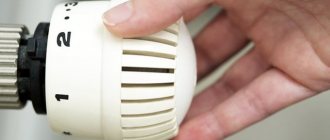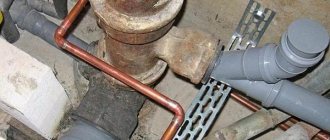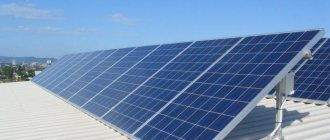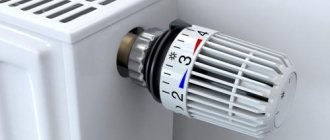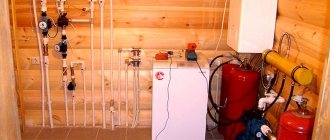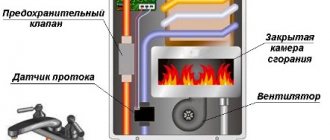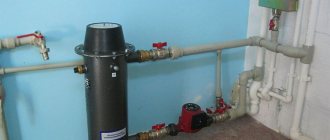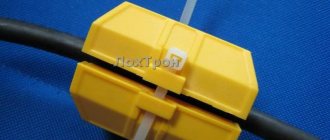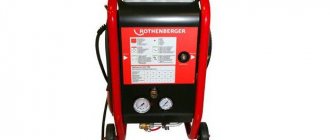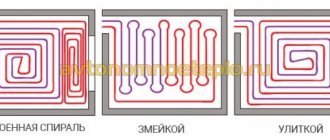Video description
In our video we’ll talk about heating in a private country house. Our guest is the author and presenter of the Teplo-Voda channel Vladimir Sukhorukov:
Oil radiator
Considered uneconomical - critics argue that it should not be used as a heating device due to high energy consumption and low output. But it is this type of device that has one of the highest efficiency - about 98%. That is, it converts almost all electrical energy into heat (the law of conservation of energy has not yet been canceled), and those minor losses of 2% are due to the resistance of the internal walls of the radiator to the coolant. Yes, it is inertial - it takes a long time to warm up, but it also takes a long time to cool down.
Another drawback is that it takes a long time to warm up the room.
But this is a property of all batteries, including water heating, in which the main method of heat transfer is natural convection, and it proceeds slowly.
The main disadvantage is the “rough” power control and the use of mechanical thermostats. And such inaccurate control of temperature conditions makes an oil radiator ineffective when trying to optimize the cost of heating with electricity in a private home. And yet, it has a rather high body temperature when operating at full power, which is dangerous if there are small children in the house.
There are models of oil radiators that can be hung on the wall Source b-sector.ru
Fan heater
It is often written about a fan heater that it burns oxygen. But “oxygen combustion” is nothing more than an oxidation (combustion) process, and the maximum that can burn at a fairly low temperature of the coil is organic dust in the air. Therefore, it is incorrect to talk about burning oxygen (after all, it’s not wood that burns) since this insignificant volume must be replenished as a result of mandatory ventilation of the room.
The efficiency of such a device is slightly lower than that of an oil radiator (part of the electricity is spent on operating the fan), but it is not very different, considering that the power of the fan motor itself is small (about 50 W out of a total of 1 or 2 kW). The advantage is that the room warms up very quickly. Disadvantages are a constant noise level (albeit insignificant) and dust transfer throughout the room. And the main drawback of these household appliances is manual power adjustment and the illusory possibility of creating an automated heating system based on fan heaters
A fan heater is the most compact heating device, and it is great for heating a small area Source romb.ua
Therefore, it is necessary to emphasize once again that the main reason why some types of electric heaters are not suitable for heating a home is not the efficiency (almost all of them are above 95%), but the impossibility of automating system control. It is this factor that does not allow optimizing the operation of the heating system, and without this it is impossible to heat a house with electricity cheaply.
Equipment used
Electric heating of a private home can be organized using various equipment. Each option has its own distinctive features that deserve close attention.
Electric convectors
This option may be of interest to those looking for an economical solution. A converter with suitable technical characteristics allows you to organize effective heating of the internal space with minimal financial investment. Its operating principle is based on the use of natural air circulation. The air mass heated inside the device rises to the ceiling. Thanks to this, the air inside the room begins to move more actively, ensuring the heating of each microvolume.
The advantages of using electric converters include:
- The use of natural circulation, which avoids the movement of solid dust particles that are inevitably present on the surface. Thanks to this, it is possible to avoid negative effects on people’s health;
- Compactness. Electric converters do not take up much space, generating sufficient power;
- Fast heating of heating elements;
- Quite high efficiency, reaching 80%;
- Possibility of changing the operating mode;
- Regulating the degree of heating of the air in the room within a given range;
- Mobility. The electric converter can always be moved to another place or room;
- Possibility of use as a main and additional system. In the latter case, the equipment is used in conjunction with devices of another type and type;
- Limitation on the degree of heating of the case. In most devices it does not heat above 60 °C. The temperature of the heating element does not exceed 100 °C.
The disadvantages of this method of heating a private home include the need to install equipment in each room. When all devices are turned on simultaneously, power consumption increases significantly. This will not only increase your energy costs, but may also cause the grid to become overloaded, causing it to fail.
Tubular electric heaters
Heating a house with electricity can be realized using tubular electric heaters. The heat they generate is transferred to a coolant fluid circulating in a circle and then into the surrounding space. Their operating principle is similar to the operation of an electric kettle. This is why tubular electric heaters are sometimes called oil radiators.
The advantages of using them in a private home for organizing heating with electricity include:
- High efficiency;
- Safety during operation;
- Reliable design;
- Versatility of use;
- Resistance to negative external influences;
- A large assortment. You can always choose a model with a suitable design depending on the installation location.
Among the disadvantages, it is worth noting the high cost of heating elements.
Warm floor
It is often used as additional electric heating in apartments and houses. Allows you to completely get rid of radiators. Provide uniform heat distribution throughout the space. Allows you to maintain the degree of air heating in a given range without a boiler.
When calculated correctly, it is often used as the main source of heat. With its help, you can organize heating from electricity in a private house of any size, located in any region.
Electric boiler
Most often, water heating is chosen to heat suburban real estate. To heat the coolant circulating through the pipes, a boiler with different characteristics and operating principles is used. It is possible to install the device:
- with heating element. They are cheaper than other types of devices. Safe and reliable to use. They have an affordable price. They do not create problems during maintenance. However, this choice cannot be called the most economical. Electricity costs are significantly higher, which should be taken into account when choosing electric boilers of this type;
- induction type. To heat the coolant, the heat given off by the current induced in the secondary winding is used. Such devices allow you to quickly warm up the surrounding space. They remain operational at low voltage. They have high efficiency, reaching 100%;
- electrode type. The energy source is electrodes that ensure the passage of current through the coolant liquid. This prevents scale from forming on the heating element. This significantly increases the service life of the equipment and increases its reliability during operation. Such equipment is often the best option when choosing electric heating for a summer house. The device has compact dimensions and allows you to rationally manage free space.
Infrared heaters
Often chosen for a country house. Of all types of equipment used, it allows you to organize heating of the room in a limited time. The devices produce heat, which then heats objects inside the room. Heat is transferred from heated products to the surrounding space. As a result, the air gradually warms up to a comfortable temperature.
May be implemented in different ways. Particularly popular are infrared panels that can be installed in any spatial position. Suitable not only for residential buildings, but also for industrial premises.
It is possible to install an infrared heated floor, which can be done at any time, and not just during the construction of a house or renovation. This option can be implemented on your own, even without much experience in construction work.
Infrared heaters are the most economical way to heat your home using electricity. It can act as the main source of heat, but is most often used for additional heating.
Efficient methods of heating with electricity
Heating with electricity in a private house has the main advantages over all others - these are simple and accurate methods for monitoring and regulating the operation of all components and elements. Even the sensors and display of information about operating modes are more accurate than those of equipment using other types of energy carriers.
Individual electric heating of a private house has three options for heating systems:
- autonomous water heating systems based on electric boilers:
- use of infrared ceramic heaters;
- electric convectors with electronic thermostats.
All these systems can be adapted into a smart home system and controlled remotely.
Ways to save extra money with electric heating
Following simple energy saving measures will help you cheaply heat your home with electricity.
- Insulation of building walls - it is advisable to carry it out from the outside of the walls. Internal insulation is fraught with the formation of condensation between the wall and the insulation and requires strict adherence to technology and additional insulation measures.
- Reducing heat loss with natural ventilation by replacing windows and doors with energy-efficient ones.
- The use of a multi-tariff electricity meter is relevant, first of all, for electric heating systems with a boiler, because The operating principle of heaters requires almost constant maintenance of the specified parameters.
- Use of heat accumulators - applicable only for systems with boiler equipment. Provided that you have a multi-tariff electric energy meter installed, you can, in order to save money, accumulate thermal energy using a battery at night.
Important! To some extent, the heating system coolant also acts as a storage unit, so an electric heating boiler system is able to maintain heat in the house in the event of short-term power outages.
Heating with electric boiler
This is a classic diagram of an autonomous heating system. There are two options for heating the coolant - indirect and direct.
Electric boilers of indirect heating come in two types: heating elements and induction.
The design and principle of operation of heating element boilers are quite simple - there is a heating coil enclosed in a sealed metal shell with a dielectric heat-conducting filler, the heat from the spiral through the filler is transferred to the surface of the heating element shell, with which the heating system coolant is in contact.
This is what the “filling” of a 9 kW heating element boiler looks like, which, despite its compact size, is capable of heating a house of 100 m2 Source mirvera.ru
Induction boilers have appeared for domestic heating systems relatively recently. Their operating principle lies in the property of metals to heat up under the influence of an alternating magnetic field. The heating element itself is an inductive coil with a ferromagnetic alloy core, through the “secondary winding” of which the coolant passes.
Scheme of operation of an induction heater Source josri.ru
The peculiarity of direct heating electric boilers is that water not only acts as a coolant, but is also part of the electrical circuit - alternating current passes through it between the electrodes. Hence the name of the boilers - electrode.
Each type of boiler has its own disadvantages. Heating elements form scale, which leads to a decrease in the useful power and service life of the boiler. Induction ones are quite expensive, bulky and have “stepped” power adjustment. Electrode ones have strict restrictions on the quality and composition of water, which must have a certain specific electrical resistance to alternating current.
A cascade of four electrode boilers for heating a large house Source obriy-ua.com
Well, the main disadvantage of heating a country house with an electric boiler is the presence of the coolant itself and the “bulky” circulation system of pipes and radiators. Setting up such a system is costly, and the efficiency compared to direct electric heaters may be lower if circulation pumps are used.
Induction boilers
This equipment includes a radiator and a pipeline through which the coolant circulates. Induction-type electric boilers for heating a house can be considered the best due to the absence of a heating element in them. The emitter located in the device produces an electromagnetic field that interacts with the metal. In this case, vortex flows are created that transfer their energy to the coolant.
The power consumption of an induction electric boiler for heating a house is 220V. Its advantages include ease of installation and further maintenance. In addition, such a unit does not have wearable elements, and scale formation in it is possible only in minimal quantities. Experts recommend the use of such boilers for heating large rooms using a coolant in the form of water, oil or antifreeze.
A significant disadvantage of such equipment is its impressive size and high cost. In addition, damage to the integrity of the circuit leads to such a boiler failure due to a dangerous increase in temperature.
Video description
Video about infrared heaters:
There are three fundamentally different types of infrared heaters:
- reflectors in which the filament coil is enclosed in a quartz glass bulb;
- panel - a heating element is “soldered” in a ceramic monolithic slab;
- film - with carbon coating on a polymer film.
Heating a house with electricity of the first type refers to heaters operating in the short-wave range of infrared radiation.
Such devices can be used as an additional heater, but not as a basic element of the heating system of a private house with electricity.
Disadvantages - the lowest efficiency (due to the visible part of the radiation), lack of precise temperature control and high case temperature.
The second type of device operates in the soft long-wave range. The maximum temperature of the ceramic panel does not exceed 90°C, but on the body it is even lower. There are two types of control - mechanical and electronic thermostat. The first option involves manual control and its accuracy is low. Using electronic thermostats, you can set the temperature with an accuracy of 1°C.
The infrared panel is so safe that it can be hung on wooden walls Source centr-tepla.in.ua
Film heaters are the most efficient. They are usually used as part of underfloor heating, but in principle they can be mounted in walls or on the ceiling. But it is the installation as part of the floor covering that most closely corresponds to the correct and uniform heating of the room. Operation is controlled automatically using a temperature sensor-thermostat pair.
If there is not enough space on the floor, then the film heater can be mounted on any free plane Source otdelka-expert.ru
Why choose electric heating?
It is generally accepted that heating a home with systems powered by electricity is too expensive. Therefore, their advantages are somehow not taken into account.
Electric heating systems are among the most environmentally friendly. They do not produce any emissions into the atmosphere
This is fundamentally wrong, because electrical systems have many significant advantages that distinguish them from other types of heating:
- Safety. The equipment does not work with open flames or explosive substances, like other heating devices. High-quality wiring provides reliable protection against possible fire.
- Easy to operate and maintain . Automatic systems regulate the operation of equipment, which requires minimal human intervention. There are no elements that require regular replacement or cleaning.
- Complete environmental safety. During operation, the system does not emit toxic substances, so it can be installed in any room.
- No need to store fuel reserves. Therefore, a special room for storing flammable materials is not required.
- Compactness. Most of the equipment is small in size. The varied design of the devices makes it easy to choose a model for any interior style.
- Low cost . Compared to other types of heating devices, the price of such equipment is much lower.
Among the significant disadvantages of electrical systems, in addition to the fairly high cost of electricity, in fairness, it should be noted that the equipment is completely energy dependent.
This means that if there is a power outage, all appliances will stop working, which will be especially noticeable in areas with frequent outages. In addition, for uninterrupted operation of the equipment, you will need a powerful electrical network, which is not available everywhere.
To install water heating with an electric boiler, choose only a closed system with an expansion tank equipped with a membrane, with which the pressure in the system is regulated
Convectors
In appearance, convectors are very similar to ceramic panel heaters, but inside the metal case there is an “open” heating element enclosed inside a plate radiator. The fundamental difference is in the heating method - cold air enters the case through the bottom row of holes, comes into contact with the radiator, heats up and exits through the top row of holes.
The convector housing not only serves as protection for the heating element, but also increases the speed of the upward flow. Due to this, with the same power, the room is heated faster than from a water heating battery.
The stylish convector panel looks great in a modern interior Source teplo-vsem.ru
Like ceramic panel heaters, there are two types of thermostats - mechanical and electronic. And it is the electronic control of the work that ensures the accuracy of adjustment and the ability to work in several modes:
- individual, with manual control, used for heating a separate room;
- group, operation of several devices under the control of one (common) thermostat, which ensures uniform heating of a large area or the same heating mode for several rooms;
- intelligent, control using a remote control, connection to a GSM module and control using standard commands from a remote terminal (mobile communications, Internet), connection to a router and control via a local network and/or the Internet.
Heating convectors
Convectors are marketed as devices with heating elements that are open to air. When air comes into contact with a heat source, it quickly warms up and rises. Cooled air enters the lower part of the room and rises again, heated by the convector. This is how the natural circulation of hot and cold air masses occurs. Some modifications are equipped with a protective screen that sets a certain direction for the warm air flow. The presence of a special fan allows you to speed up air circulation in the room.
Classification of convectors
Main characteristics:
- Installation – floor, wall (horizontal and vertical), ceiling, built-in;
- Heating principle – heating element and infrared;
- Circulation – natural and forced;
By type of installation:
Floor structures benefit from mobility. The disadvantages include the presence of a power cord, the use of which is inconvenient in a home with a small child. Wall-mounted models attract the attention of consumers with their small thickness. This allows installation under the window and protects the room from the penetration of cold air flow.
The choice of built-in baseboard heaters is justified when equipping large-sized rooms, where installing wall-mounted options will not allow heating a large area. The disadvantages include the need to plan the heating system during the construction of the room, since it is necessary to prepare special niches in the floor for the convector, channels for laying a pipeline supplying hot coolant.
To speed up the heating of large rooms, powerful fans are used. In small rooms, built-in steel units are often used, mounted under the baseboard, in the body of built-in furniture.
General characteristics
Parameters required for all types of convectors:
- Thermal sensors are electronic, programmable or mechanical thermostats used to set the most comfortable degree of air heating.
- Electronic sensors aimed at the safe use of the convector. All heating devices made of aluminum, steel or bimetallic are equipped with an overheating sensor; upon reaching the operating temperature of the convector, the power supply is automatically turned off and the circulation of the coolant is prevented. Some models are equipped with a rollover sensor. This allows the heater to stop operating if the position changes.
- Screen (air damper) - stationary and mobile options for adjusting the direction of the flow of heated air.
An example of a real system with an intelligent control circuit for electric heating at home
NOBO, a leading European manufacturer of convectors, produces two compatible systems for “smart” control of electrical appliances. Including “warm floors” (via a thermostat) and any other household appliances that are connected to the network (via a panel, a “break” in the circuit or turning on/off sockets). To do this, they produce special thermostats, socket receivers and hidden-mounted relay receivers.
Using such a system, you can monitor and manage the operation of up to 100 devices or group zones. And 700 series thermostats provide 4 operating modes for convectors: comfortable, economical, non-freezing (air temperature 7°C) and “off”. According to the manufacturer, the flexibility of such a control system for convectors and heated floors allows you to save up to 25% on electric heating at home.
One of two control schemes for a multi-zone electrical system Source stroydoma74.ru
Wiring safety
The main criterion for the safe use of electric heating is high-quality wiring and compliance with all building codes when installing equipment. In addition, heating a cottage with electricity will require optimization of the entire network. The power supply system must withstand various loads, especially during cold periods.
In physics, a short circuit is an unplanned connection of electrical conductors with different potentials, resulting in the formation of destructive currents. In simple terms, zero resistance is formed in the electrical circuit, which leads to fire.
Signs of short circuit and wiring overload:
- the smell of burning;
- smoke;
- burnt fuses;
- charred wiring;
- a black trace at the site of the short circuit.
To avoid a short circuit, you should become familiar with the situations in which it can occur. The reasons why a short circuit occurs include :
- violation of standards when installing electrical equipment and replacing wiring;
- wear of the wiring, as a result of which the contacts weaken and the winding wears off;
- the appearance of mold, the formation of cracks on the body of the sockets;
- exceeding the permissible load on the wiring.
Even a new electrical network can be subject to short circuits. Most often, overload occurs when residents use many high-power appliances at the same time.
When changing wiring, it is recommended to install a dual-zone meter. This will significantly reduce energy costs.
